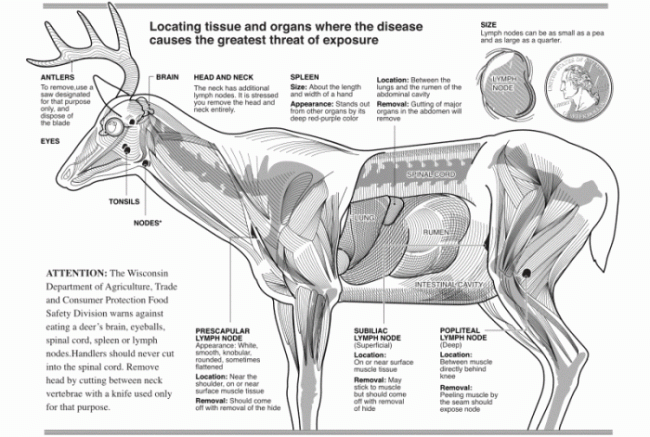Chronic wasting disease is a fatal, contagious, neurodegenerative disease that affects members of the deer family. CWD is caused by a misfolded protein called a prion (pronounced “pree-on”) and belongs in a group of diseases known as transmissible spongiform encephalopathies (TSEs). TSEs are similar to bovine spongiform encephalopathy (BSE; aka mad cow disease). Eventually, the infected deer undergoes spongy degeneration of the brain and other nervous tissue. As of early 2025, CWD has been found in 36 states and four Canadian provinces.
CWD is very difficult to manage once it has become established on the landscape. There are no known vaccines or cures for any prion diseases, including CWD. The prions can remain in the environment for years or even decades and are extremely difficult to destroy. Studies have indicated that CWD can lead to long-term declines in deer populations. The risk to human health is not zero. Recent studies have indicated that CWD is transmissible to species of primates that are genetically similar to humans, but there does seem to be a strong species barrier between infected cervids and humans. If CWD spreads into the Ceded Territories, this would threaten a significant source of traditional food for tribal communities.
Report sick deer
If you observe and/or shoot a deer that appears to be sick, immediately report the deer to the nearest tribal registration clerk, GLIFWC biologist, conservation warden, or your local state DNR biologist. Avoid handling or consuming any deer that looks sick.
Get your deer tested
If you would like to get your deer tested for CWD, please contact your local tribal registration station, GLIFWC biologist, or state DNR office. When preparing the deer head for testing, it is important to leave 3 - 5 inches of the neck attached to the head. Preliminary test results are typically available within a couple of weeks.
Prevent the spread!
Proper disposal is key to preventing the long-distance spread of CWD. Regardless of where the deer was harvested, all carcass parts and waste should be bagged, sealed, and brought to the local landfill if possible. If your landfill will not accept carcass waste, bury the remains deep enough to prevent scavengers from digging them up. Some tribal communities have passed carcass transport regulations to prevent the spread of CWD from endemic areas to their tribal lands in the Ceded Territories. Hunters are encouraged to try to minimize the transport of whole deer carcasses and consider field dressing and butchering/processing deer as close to the point of kill as possible, especially if they are hunting in an area where CWD has been detected in the wild deer herd.

- Always wear latex/rubber gloves when field dressing and butchering your deer.
- Use knives/tools that are dedicated to butchering/processing your deer – do not use knives that you normally use in your kitchen.
- Use a disposable cutting surface such as clean plywood or paneling.
- Avoid sawing or cutting through any bones, the spinal column, the eyes, spleen, or lymph nodes (see image below).
- Trim meat a considerable distance away from any shattered or broken bone.
- Completely bone-out all of the meat and remove excess fat and connective tissue.
- Seal all disposable materials and equipment used for processing your deer in plastic trash bags and dispose of in a landfill when possible. You can also bury the remains.
- Process individual deer separately and carefully label meat from any deer you are getting tested.